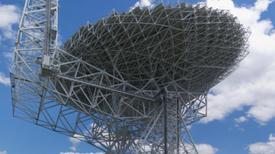
Would You Bet Your Species on "Earth-Like"?
The announcement of a newly confirmed exoplanet in Kepler data within its star's "habitable zone" is great news, but also reinforces some misconceptions about what an Earth-like world means...

The announcement of a newly confirmed exoplanet in Kepler data within its star's "habitable zone" is great news, but also reinforces some misconceptions about what an Earth-like world means...

The planet, Kepler 452 b, is likely rocky and orbits in its star’s habitable zone where liquid water can exist

With a $100-million donation, billionaire Yuri Milner plans to revolutionize the astronomical quest to find alien life

Entrepreneur and former physicist Yuri Milner talks about the just-announced $100-million Breakthrough Listen Project to search for extraterrestrial technological civilizations ...

Milner, a tech start-up entrepreneur and philanthropist, is partnering with scientists around the world to search for life among the stars

High-resolution images of the icy worlds reveal towering mountains, yawning canyons and perhaps hints of a subsurface ocean

Early this morning, if all has gone well, the first golden age of interplanetary exploration will have come to a close

Though hobbled by age, NASA’s Kepler planet-hunting telescope is proving to be an almost inexhaustible engine of discovery. The observatory found thousands of new worlds before an equipment malfunction in 2013 slowed its planetary torrent to a trickle, but clever researchers have managed to squeeze remarkable new findings out of its vast trove of archival data...

NASA’s former director of astrophysics plans to revolutionize space science with agile, privately funded missions

Brown University researchers have detected glass deposits on Mars that might contain evidence of past conditions and, possibly, life

Scientists have found ancient "impact glass" on the surface of Mars, which formed when asteroids struck, a billion or more years ago. If anything was alive at the time, biological materials could be trapped inside...

The Thirty Meter Telescope can revolutionize astronomy and become a part of the holy mountain’s rich cultural heritage

Bright spots in the latest pictures from NASA’s mission to the dwarf planet may be water ice, researchers say

Two new studies hint at a richer picture of what’s happening on Saturn’s extraordinary icy moon Enceladus. At about 500 kilometers in diameter, Enceladus is a diminutive natural satellite...

Controversy swirls around a bold proposal for a bigger, better—and expensive—replacement for NASA’s premier space telescope

Two prominent scientists update our view of the history of life on Earth, featuring the prominent roles of oxygen and carbon dioxide, and question claims that it is fairly easy to initiate life—even on a planet such as ours...

On April 30, if all goes well, after running out of fuel to fight off orbital decay NASA’s long-running MESSENGER spacecraft will end its mission to Mercury by crashing into the planet’s surface at nearly 4 kilometers per second...

The most far-seeing search ever performed for “Dyson spheres” and other artifacts of “astroengineering” comes up empty. Where is everybody?

A recent article by Samuel Arbesman in the science magazine Nautilus discusses the extraordinary sounding possibility that – just perhaps – a search for extraterrestrial intelligence could be made by looking at our DNA...

Radar measurements and models of Earthly glacial ice flows led researchers to conclude that the glaciers spotted on Mars from orbiters contain nearly 150 billion cubic meters of water. ..
Support science journalism.

Thanks for reading Scientific American. Knowledge awaits.
Already a subscriber? Sign in.
Thanks for reading Scientific American. Create your free account or Sign in to continue.
Create Account